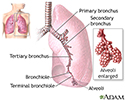Respiratory
RespirationThe words "respiratory" and "respiration" refer to the lungs and breathing.
References
Dezube R. Overview of the respiratory system. Merck Manual Consumer Version website. www.merckmanuals.com/home/lung-and-airway-disorders/biology-of-the-lungs-and-airways/overview-of-the-respiratory-system?query=respiratory%20system. Updated January 2023. Accessed October 19, 2024.
-
Lungs - illustration
The major features of the lungs include the bronchi, the bronchioles and the alveoli. The alveoli are the microscopic blood vessel-lined sacks in which oxygen and carbon dioxide gas are exchanged.
Lungs
illustration
-
Upper respiratory tract - illustration
The major passages and structures of the upper respiratory tract include the nose or nostrils, nasal cavity, mouth, throat (pharynx), and voice box (larynx). The respiratory system is lined with a mucous membrane that secretes mucus. The mucus traps smaller particles like pollen or smoke. Hairlike structures called cilia line the mucous membrane and move the particles trapped in the mucus out of the nose. Inhaled air is moistened, warmed, and cleansed by the tissue that lines the nasal cavity.
Upper respiratory tract
illustration
-
Lower respiratory tract - illustration
The major passages and structures of the lower respiratory tract include the windpipe (trachea) and within the lungs, the bronchi, bronchioles, and alveoli. Deep in the lungs, each bronchus divides into secondary and tertiary bronchi, which continue to branch to smaller airways called the bronchioles. The bronchioles end in air sacs called the alveoli. Alveoli are bunched together into clusters to form alveolar sacs. Gas exchange occurs on the surface of each alveolus by a network of capillaries carrying blood that has come through veins from other parts of the body.
Lower respiratory tract
illustration
-
Lungs - illustration
The major features of the lungs include the bronchi, the bronchioles and the alveoli. The alveoli are the microscopic blood vessel-lined sacks in which oxygen and carbon dioxide gas are exchanged.
Lungs
illustration
-
Upper respiratory tract - illustration
The major passages and structures of the upper respiratory tract include the nose or nostrils, nasal cavity, mouth, throat (pharynx), and voice box (larynx). The respiratory system is lined with a mucous membrane that secretes mucus. The mucus traps smaller particles like pollen or smoke. Hairlike structures called cilia line the mucous membrane and move the particles trapped in the mucus out of the nose. Inhaled air is moistened, warmed, and cleansed by the tissue that lines the nasal cavity.
Upper respiratory tract
illustration
-
Lower respiratory tract - illustration
The major passages and structures of the lower respiratory tract include the windpipe (trachea) and within the lungs, the bronchi, bronchioles, and alveoli. Deep in the lungs, each bronchus divides into secondary and tertiary bronchi, which continue to branch to smaller airways called the bronchioles. The bronchioles end in air sacs called the alveoli. Alveoli are bunched together into clusters to form alveolar sacs. Gas exchange occurs on the surface of each alveolus by a network of capillaries carrying blood that has come through veins from other parts of the body.
Lower respiratory tract
illustration
Review Date: 10/9/2024
Reviewed By: Linda J. Vorvick, MD, Clinical Professor, Department of Family Medicine, UW Medicine, School of Medicine, University of Washington, Seattle, WA. Also reviewed by David C. Dugdale, MD, Medical Director, Brenda Conaway, Editorial Director, and the A.D.A.M. Editorial team.





